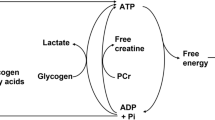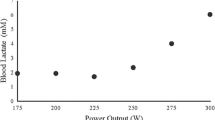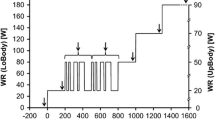Summary
The purpose of the present study was to assess the relationship between the rapidity of increased gas exchange (i.e. oxygen uptake\(\dot VO_2 \)) and increased cardiac output (\(\dot Q_c \)) during the transient phase following the onset of exercise. Five healthy male subjects performed multiple rest-exercise or light exercise (25 W)-exercise transitions on an electrically braked ergometer at exercise intensities of 50, 75, or 100 W for 6 min, respectively. Each transition was performed at least eight times for each load in random order. The\(\dot VO_2 \) was obtained by a breath-by-breath method, and\(\dot Q_c \) was measured by an impedance method during normal breathing, using an ensemble average. On transitions from rest to exercise,\(\dot VO_2 \) rapidly increased during phase I with time constants of 6.8–7.3 s. The\(\dot Q_c \) also showed a similar rapid increment with time constants of 6.0–6.8 s with an apparent increase in stroke volume (SV). In this phase I,\(\dot VO_2 \) increased to about 29.7%–34.1% of the steady-state value and\(\dot Q_c \) increased to about 58.3%–87.0%. Thereafter, some 20 s after the onset of exercise a mono-exponential increase to steady-state occurred both in\(\dot VO_2 \) and\(\dot Q_c \) with time constants of 26.7–32.3 and 23.7–34.4 s, respectively. The insignificant difference between\(\dot Q_c \) and\(\dot VO_2 \) time constants in phase I and the abrupt increase in both\(\dot Q_c \) and SV at the onset of exercise from rest provided further evidence for a “cardiodynamic” contribution to\(\dot VO_2 \) following the onset of exercise from rest.
Similar content being viewed by others
References
Adams L, Guz A, Innes JA, Murphy K (1987) The early circulatory and ventilatory response to voluntary and electrical exercise in man. J Physiol 383:19–30
Cummin ARC, Iyawe VI, Mehta N, Saunders KB (1986) Ventilation and cardiac output during the onset of exercise, and during voluntary hyperventilation, in humans. J Physiol 370:567–583
Denniston JC, Maher JT, Reeves JT, Cruz JC, Cymerman A, Grover RF (1976) Measurement of cardiac output by electrical impedance at rest and during exercise. J Appl Physiol 40:91–95
Eriksen M, Waaler BA, Walloe L, Weche J (1990) Dynamics and dimensions of cardiac output changes in humans at the onset and at the end of moderate rhythmic exercise. J Physiol 426:423–437
Hatcher DD, Srb OD (1986) Comparison of two noninvasive techniques for estimating cardiac output during exercise. J Appl Physiol 61:155–159
Hughson RL (1990) Exploring cardiorespiratory control mechanisms through gas exchange dynamics. Med Sci Sports Exerc 22:72–79
Hughson RL, Morrissery M (1982) Delayed kinetics of respiratory gas exchange in the transition from prior exercise. J Appl Physiol 52:921–929
Kubicek WG, Karnegis JN, Patterson RP, Witsoe DA, Matton RH (1966) Development and evaluation of an impedance cardiac output system. Aerosp Med 37:1208–1212
Kubicek WG, Kottke FG, Ramos MU (1974) The Minnesota impedance cardiograph-theory and applications. Biomed Eng 9:410
Loeppky JA, Greene ER, Hoekenga DE, Caprihan A, Luft UC (1981) Beat-by-beat stroke volume assessment by pulsed Doppler in upright and supine exercise. J Appl Physiol Respir Environ Exerc Physiol 50:1173–1182
Miyamoto Y, Takahashi M, Tamura T, Nakamura T, Hiura T, Mikami T (1981) Continuous determination of cardiac output during exercise by the use of impedance cardiography. Med Biol Eng Comput 19:638–644
Miyamoto T, Hiura T, Tamura T, Nakamura T, Higuchi J, Mikami T (1982) Dynamics of cardiac, respiratory, and metabolic function in men in response to step work load. J Appl Physiol Respir Environ Exerc Physiol 52:1198–1208
Miyamoto Y, Higuchi J, Abe Y, Hiura T, Nakazono Y, Mikami T (1983) Dynamics of cardiac output and systolic time intervals in supine and upright exercise. J Appl Physiol Respir Environ Exerc Physiol 55:1674–1981
Morikawa T, Ono Y, Sasaki K, Sakakibara Y, Tanaka Y, Maruyama R, Nishibayashi Y, Honda Y (1989) Afferent and cardiodynamics drives in the early phase of exercise hyperpnea in humans. J Appl Physiol 67:2006–2013
Muzi M, Ebert TJ, Tristani FE, Jeutter DC, Barney JA, Smith JJ (1985) Determination of cardiac output using ensemble-averaged impedance cardiograms. J Appl Physiol 58:200–205
Noguchi N, Ogushi Y, Yoshiya I, Itakura N, Yamabayashi H (1982) Breath-by-breath\(\dot VCO_2 \) and\(\dot Q_c \) require compensation for transport delay and dynamic response. J Appl Physiol 52:79–84
Teo K-K, Hetherington MD, Haennel RG, Greenwood PV, Rossall RE, Kappagoda T (1985) Cardiac output measured by impedance cardiography during maximal exercise tests. Cardiovasc Res 19:737–743
Wasserman K, Whipp BJ, Castagna J (1974) Cardiodynamic hyperpnea: hyperpnea secondary to cardiac output increase. J Appl Physiol 36:457–464
Wasserman K, Hansen JE, Sue DY, Whipp BJ (1987) Principles of exercise testing and interpretation. Lea & Febiger, Philadelphia, pp 3–26
Whipp NJ, Ward AS, Lamarra N, Davis JA, Wasserman K (1982) Parameters of ventilatory and gas exchange dynamics during exercise. J Appl Physiol Respir Environ Exerc Physiol 52:1506–1513
Yoshida T, Ishiko T (1978) Physiological studies on cardio-respiratory response to exercise and validity of endurance tests in ten-year-old boys. In: Landry F, Orban WAR (eds) Exercise physiology. Symposia Specialists, Miami, pp 541–545
Author information
Authors and Affiliations
Rights and permissions
About this article
Cite this article
Yoshida, T., Yamamoto, K. & Udo, M. Relationship between cardiac output and oxygen uptake at the onset of exercise. Europ. J. Appl. Physiol. 66, 155–160 (1993). https://doi.org/10.1007/BF01427057
Accepted:
Issue Date:
DOI: https://doi.org/10.1007/BF01427057




